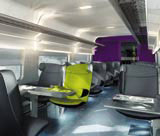The space age

For its new interiors, France’s high speed TGV trains called in Christian Lacroix. Natasha Edwards speaks to the designer responsible for their new bright, rounded asymmetric forms
I went to the first meeting with a picture of an egg on a vertebra,’ says Christian Lacroix. ‘It expresses that, for me, the train is a backbone, able to protect the most fragile thing in the world. I wanted to keep an organic shape for the seats, so they are weightless, very light and suspended in the air.’ The result is a comforting rounded shell, in which seat and back form a single curve. The new structure, developed by specialist seat manufacturer Compin, suspends each pair of chairs from a streamlined, aluminium-finish, central column or mast, which also serves as a support for all the accessories, including rubbish bin, reading lights, foot-rest, goblet-holder and ticket pouch. The overall impression is that of flotation and fluidity, freeing space behind and under the chair, which also makes it easier to clean and allows passengers to move along the central corridor with their luggage.
It’s all part of a deliberate desire for modernity by the SNCF, France’s nationalised rail operator. ‘The high-speed train remains a dream in people’s imagination. We needed to maintain the TGV’s headstart by doing something strong,’ says executive managing director Guillaume Pépy.
The bright colours, for which Arles-born Lacroix is legendary, inspired by the southern sun and bull-fighting, are the most obvious feature he has brought from couture. The daring colour combinations don’t just change the ambience – ‘I wanted to get away from the grey-beigeness of travel,’ he explains. With vibrant purple and red in second class, evoking ‘family and leisure’, and calmer, more business-like grey and apple green in first, the palette also creates an optical effect that breaks the long corridor syndrome of the train. ‘I proposed to have different colours for some seats in each car, to avoid a severe, straight bus effect,’ explains Lacroix. The original red-dominated colour scheme, proposed for second-class, was judged ‘too flashy’ by the public and reversed in favour of a purple-dominated one.
Rethinking the lighting was also high priority. The fluorescent lighting has three levels: full for boarding, 50 per cent while in motion, and dimmed right down overnight, between 10pm and 7am. Each seat has a personal reading lamp for those who wish to read. Three different ambient light sources – on the ceiling, over windows and on the piers between windows – create a series of arched washes, again intended to reduce the tubular effect of the train. The impression of luminosity is increased by pale ceilings and by replacing the curtains (which tended to obstruct the view) with blinds.
As in his recent hotel and cinema interiors, Lacroix has introduced his distinctive graphic style: a dynamic curlicue script indicating ‘2e classe’, ‘Bureau’, ‘Comptoir’ and so on, plus patterned tabletops and a carpet graphic inspired by the watery reflections of the Atlantic.
In a country where, despite the long distances, efficient, high-speed trains seriously rival air travel, the SNCF emphasises comfort and space, as opposed to the cram-them-in, no-frills ethos of low-cost airlines. So Compin reworked its inital maquette to produce a deeper, softer seat. Luggage racks were located within compartments, in response to the reluctance of passengers to leave their suitcases near the doors, and there is improved overhead storage. Taller passengers will appreciate the 7cm gain in leg room.
Allied to comfort is the idea of an autonomous space, in which each passenger can personalise his territory, from the reclinable back and adjustable headrest of each seat, via the reading light and gamut of new storage pockets, to specially designated areas.
In second class, ‘bureau’ zones with electric sockets and banquette seating reinforce the mobile office concept, while family areas have fold-up chair seats and retractable tables to create playroom and tabletops printed with boardgames.
-
Post a comment



